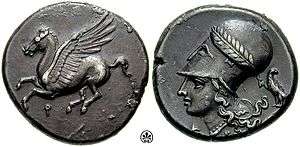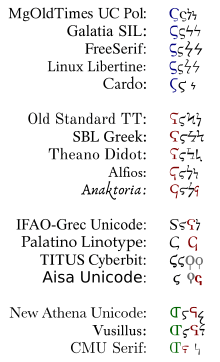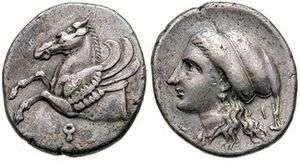Koppa (letter)
Koppa or qoppa (Ϙ, ϙ; as a modern numeral sign: ![]()
![]()
 | ||||||||||||||||||||||||||||||||||||||||||||||||
| Greek alphabet | ||||||||||||||||||||||||||||||||||||||||||||||||
|---|---|---|---|---|---|---|---|---|---|---|---|---|---|---|---|---|---|---|---|---|---|---|---|---|---|---|---|---|---|---|---|---|---|---|---|---|---|---|---|---|---|---|---|---|---|---|---|---|
|
||||||||||||||||||||||||||||||||||||||||||||||||
| History | ||||||||||||||||||||||||||||||||||||||||||||||||
| Use in other languages | ||||||||||||||||||||||||||||||||||||||||||||||||
| Related topics | ||||||||||||||||||||||||||||||||||||||||||||||||
| ||||||||||||||||||||||||||||||||||||||||||||||||
Alphabetic

In Phoenician, qoph was pronounced [q̈]; in Greek, which lacked such a sound, it was instead used for /k/ before back vowels Ο, Υ and Ω. In this function, it was borrowed into the Italic alphabets and ultimately into Latin. However, as the sound /k/ had two redundant spellings, koppa was eventually replaced by kappa (Κ) in Greek. It remained in use as a letter in some Doric regions into the 5th century BC.[1]
The koppa was used as a symbol for the city of Corinth, which had the early spelling of Ϙόρινθος.
Numeric
Koppa remained in use in the system of Milesian Greek numerals, where it had the value of 90. It has continued to be used in this function into modern times, though its shape has changed over time.[2] In the Greek cursive script, the Q-like shape with a closed circle on top (handwritten as ![]()
![]()
![]()
![]()
![]()
![]()


Typography
Modern typography of the numeral Koppa has most often employed some version of the Z-shaped character. It may appear in several variants: as a simple geometrical lightning-bolt shape (![]()
![]()
![]()
![]()
![]()
![]()
As with the numeral usage of stigma (digamma) and Sampi, modern typographical practice normally does not observe a contrast between uppercase and lowercase forms for numeric koppa.[3]
Computer encoding
The Unicode character encoding standard originally (since version 1.1 of 1993), had only a single code point for Koppa, which was marked as uppercase and could be used either for an epigraphic or a numeral glyph, depending on font design. A lowercase form was encoded in version 3.0 (1999).[4][5] A second pair of code points specifically for the original closed epigraphical shape was introduced in version 3.2 (2002).[4] This left the older two code points (U+03DE/U+03DF, Ϟϟ) to cover primarily the numeral glyphs.
As of 2010, coverage of these code points in common computer fonts is therefore still inconsistent: while the most commonly used version of the numeral glyph will be located at the lowercase code point U+03DF in recent fonts, older fonts may either have no character at all or a version of the closed epigraphic form at that position. Conversely, older fonts may have the numeral glyph at the uppercase code point, while this position may be filled with any of several less common glyphs in newer ones. Since there had never been a consistent typographic tradition for a specifically uppercase numeral koppa, the typographer Yannis Haralambous proposed two new variants for it, ![]()
![]()
![]()
| Preview | Ϟ | ϟ | Ϙ | ϙ | ||||
|---|---|---|---|---|---|---|---|---|
| Unicode name | GREEK LETTER KOPPA | GREEK SMALL LETTER KOPPA | GREEK LETTER ARCHAIC KOPPA | GREEK SMALL LETTER ARCHAIC KOPPA | ||||
| Encodings | decimal | hex | decimal | hex | decimal | hex | decimal | hex |
| Unicode | 990 | U+03DE | 991 | U+03DF | 984 | U+03D8 | 985 | U+03D9 |
| UTF-8 | 207 158 | CF 9E | 207 159 | CF 9F | 207 152 | CF 98 | 207 153 | CF 99 |
| Numeric character reference | Ϟ | Ϟ | ϟ | ϟ | Ϙ | Ϙ | ϙ | ϙ |
References
- Woodard, Roger D. (1997). Greek Writing from Knossos to Homer. New York: Oxford University Press. ISBN 0-19-510520-6.
- Everson, Michael (1998). "On GREEK LETTER KOPPA" (PDF).
- Holton, David; Mackridge, Peter; Philippaki-Warburton, Irene (1997). Greek: a comprehensive grammar of the modern language. London: Routledge. p. 105.
- Unicode Consortium. "Unicode Character Database: Derived Property Data". Retrieved 2010-09-25.
- Everson, Michael (1998). "Additional Greek characters for the UCS" (PDF).
- Haralambous, Yannis (1999). "From Unicode to typography, a case study: the Greek script" (PDF). Archived from the original (PDF) on 2011-06-15.
- Nicholas, Nick. "Numerals". Archived from the original on 2012-08-05. Retrieved 2010-08-12.
Further reading
- Powell, Barry B. (1991). Homer and the Origin of the Greek Alphabet. New York: Cambridge University Press. ISBN 0-521-37157-0.
- Threatte, Leslie (1980). The Grammar of Attic Inscriptions. Berlin: Walter de Gruyter. ISBN 3-11-007344-7.
- Woodard, Roger D. (1997). Greek Writing from Knossos to Homer. New York: Oxford University Press. ISBN 0-19-510520-6.
External links
| Wikimedia Commons has media related to Koppa (letter). |
